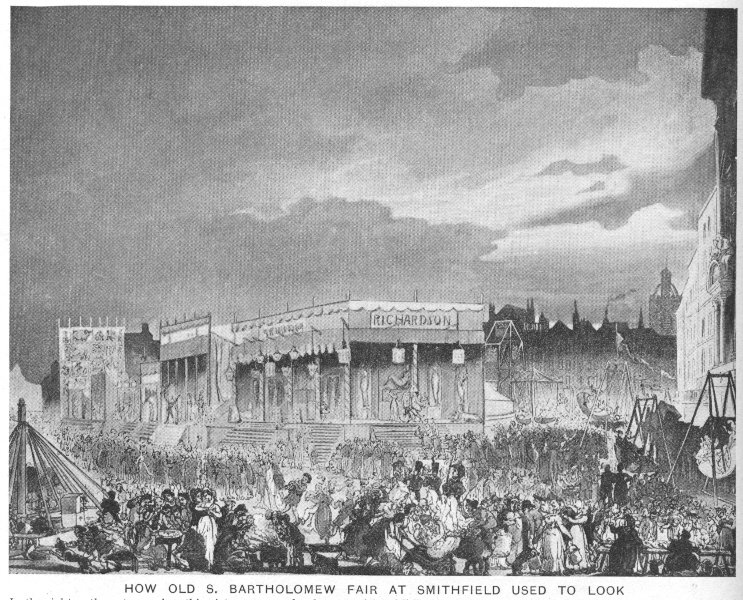Dating back to the Middle Ages, the charter fair was a street fair or market established by Royal Charter. Originally held as markets for merchant trading, by the 19th century the charter fair began to shift towards entertainment as the main attraction.
One of the most notable summer charter fairs was Bartholomew Fair, held for four days (in the 17th century it was held for two weeks) in September in London.
The public event would draw people by the thousands with carnival and circus attractions.

A memoir written by Henry Morley and published in the mid 1800s recounts his experiences as a fair representative. He writes:
“The ground of Smithfield was entirely parcelled out in booths and standings. In the centre among the sheep-pens, were those who sold in booths or at stalls oysters and sausages. Tables were set for company in a most fascinating style, and in 1808 women invited passers by into the sausage rooms with an appeal to their patriotism–for the popular political feeling still had its representation in the Fair….Outside the pens, the exhibitions were set in a row closely side by side with their backs to thepavement and their fronts to the central space of Smithfield. There also was the immense multitude of ups-and-downs and round-abouts, many of them elevated to a dangerous and painful height. On the pavement before the houses, fronting their closed doors and shutters, were the lines of gilt gingerbread and toy stalls. The show booths had, in 1808, lately become gay with unwonted decoration, and with many coloured lamps.”
Morley’s book contains some wonderful reproductions of wood cuttings/carvings for those with a visual bent. His book thoroughly details the entire history of the fair from conception to suppression, with wonderful eyewitness accounts and antecdotes.
In the Regency era, the predominant interest of the fair was its entertainment and odditities. Morley describes the performers:
” Horse-riders were favourite performers…Itinerant musicians congregated in the Fair. There was a famous London street band consisting of a double drum, a Dutch organ, a tambourine, violin, pipes, and the new Turkish jingle used in the army which used to play military pieces for a long time on winter evenings before the Spring Gardens coffee house and opposite Wigley’s great room, to entertain the diners….There was a large caravan of well known tumblers and posture-men. Bear dancing, a street sight, was an incident of bustle in the outer crowd. The bear now and then turned a good summersault and generally danced to the bagpipes. His companions were some little dogs dressed in red jackets, and a monkey who usually rode on the bear’s back.”
He also describes a popular illusionist, knive throwers and swallowers, fortune tellers combined with puppet shows (Punch a fave) and theater.
Food was equally important, with smells from hot pie sellers, fruits and vegetables combining and adding to the cacophony of noise.
It is no wonder that as the 1800s sped into the Victorian age of repression, the Bartholomew Fair was doomed.
In one form or another carnivals and fairs continue to pop up over the global landscape. As opposed to other events, it remains a budget friendly opportunity for some family entertainment. Undoubtedly for the masses of England and London, Bartholomew Fair held the same position…a fact which would ultimately lead to its demise.









